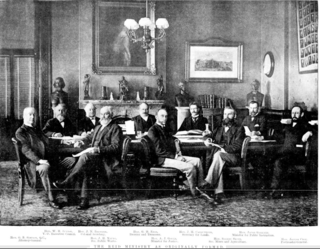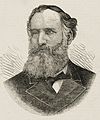Balmain, an electoral district of the Legislative Assembly in the Australian state of New South Wales, has had three incarnations since it was established in 1880. It expanded from 1 to 2 to 3 to 4 members before being abolished in 1894. It was re-established in 1904 returning 1 member until 1920. When multiple member constituencies were established using the Hare-Clark single transferable vote in 1920, Balmain returned 5 members. It had a single member from 1927 when the state returned to single member electorates. It was abolished in 1991 and largely replaced by Port Jackson which included the Sydney CBD. It was re-established in 2007 when Port Jackson was abolished.

The third Parkes ministry was the nineteenth ministry of the Colony of New South Wales, and was led by Sir Henry Parkes in a coalition with Sir John Robertson. It was the third of five occasions that Parkes was Leader of the Government.
The fifth Robertson ministry was the 22nd ministry of the Colony of New South Wales, and was led by the Premier, Sir John Robertson. It was the fifth and final occasion that Robertson was Premier. Robertson was elected in the first free elections for the New South Wales Legislative Assembly held in March 1856.

The Jennings ministry was the 23rd ministry of the Colony of New South Wales, and was led by the eleventh Premier, Sir Patrick Jennings, and the first Roman Catholic to hold the office of Colonial Premier. Jennings was first elected to the New South Wales Legislative Assembly at the 1869–70 election, and then again in 1880.
The fourth Parkes ministry was the 24th ministry of the Colony of New South Wales, and was led by the seventh Premier, Sir Henry Parkes. It was the fourth of five occasions that Parkes was Premier.

The fifth Parkes ministry was the 26th ministry of the Colony of New South Wales, and was led by the seventh Premier, Sir Henry Parkes. It was the fifth and final occasion that Parkes was Premier. The title of Premier was widely used to refer to the Leader of Government, but was not a formal position in the government until 1920. Instead the Premier was appointed to another portfolio, usually Colonial Secretary. Having served in the New South Wales Legislative Council between 1854 and 1856, Parkes was elected in the first free elections for the New South Wales Legislative Assembly held in 1856, however resigned from Parliament later that year. He served in the Assembly on several occasions, between 1858 and 1870, being forced to resign on 4 occasions due to his personal insolvency. He came to power as Premier on the first occasion in 1872, serving as Premier for a period of three years. However, Parkes lost the confidence of the Assembly following Governor Robinson's decision to release of the bushranger Frank Gardiner led to the defeat of the ministry in 1875.

The second Dibbs ministry was the 25th ministry of the Colony of New South Wales, and was the second of three occasions of being led by the tenth Premier, George Dibbs. Dibbs was elected to the New South Wales Legislative Assembly in 1874. In a period of great financial stress for the Colony, this ministry covers just 49 days from 17 January 1889 until 7 March 1889. Dibbs took over as Premier on the first occasion in October 1885 following resignation of the Alexander Stuart due to ill-health, with his ministry lasting for 75 days. Dibbs served as Colonial Secretary in the Jennings ministry, before it too suffered budgetary pressures. It was during this time that the party system was formed in New South Wales with Sir Henry Parkes leading the Free Trade Party. Dibbs had been elected as an independent free trader, however his opposition to Parkes caused Dibbs to align himself with the Protectionist Party. Dibbs had assumed office when Parkes lost a vote on the floor of the Assembly. Parliament was dissolved on 19 January 1889 and an election was held in February. There was a significant swing to the Protectionists, gaining 29 seats, however it was insufficient to command a majority of the Legislative Assembly and Parkes resumed the premiership.

The Reid ministry was the 28th ministry of the Colony of New South Wales, and was led by the 12th Premier, George Reid. The title of Premier was widely used to refer to the Leader of Government, but was not a formal position in the government until 1920. Instead the Premier was appointed to another portfolio, usually Colonial Secretary but on this occasion Reid took the portfolio of Colonial Treasurer until July 1899 and then Attorney General.
Albury, an electoral district of the Legislative Assembly in the Australian state of New South Wales, was created in 1880. It was abolished in 1920 when multiple member constituencies were established using the Hare-Clark single transferable vote. It was re-created in 1927 when the state returned to single member electorates.
Kiama, an electoral district of the Legislative Assembly in the Australian state of New South Wales, had two incarnations, the first from 1859 to 1904, the second from 1981 until the present.
Newcastle, an electoral district of the Legislative Assembly in the Australian state of New South Wales, has had two incarnations, from 1859 until 1894 and from 1904 to the present.
Bathurst, an electoral district of the Legislative Assembly in the Australian state of New South Wales, has continuously existed since 1859.
Goulburn, an electoral district of the Legislative Assembly in the Australian state of New South Wales, has had two incarnations, from 1859 until 1991 and from 2007 to the present.
Canterbury, an electoral district of the Legislative Assembly in the Australian state of New South Wales has had two incarnations, from 1859 to 1920 and 1927 to the present.
Murray, an electoral district of the Legislative Assembly in the Australian state of New South Wales, has had two incarnations, the first from 1859 to 1999, the second from 2015 to the present.

The 1891 New South Wales colonial election was held in the then colony of New South Wales between 17 June to 3 July 1891. This election was for all of the 141 seats in the New South Wales Legislative Assembly and it was conducted in 35 single-member constituencies, 20 2-member constituencies, 10 3-member constituencies and nine 4-member constituencies, all with a first past the post system. Part 1 of the Electoral Act of 1880 set the qualification for election on "every male subject of Her Majesty of the full age of twenty-one years and absolutely free being a natural born or naturalized subject". Seven seats were uncontested. The previous parliament of New South Wales was dissolved on 6 June 1891 by the Governor, The Earl of Jersey, on the advice of the Premier, Sir Henry Parkes.

The 1889 New South Wales colonial election was held between 1 February and 16 February 1889. This election was for all of the 137 seats in the New South Wales Legislative Assembly and it was conducted in 37 single-member constituencies, nineteen 2-member constituencies, ten 3-member constituencies and eight 4-member constituencies, all with a first past the post system. Part 1 of the Electoral Act of 1880 had awarded the right to vote to 'every male subject of Her Majesty of the full age of twenty-one years and absolutely free being a natural born or naturalized'. The previous parliament of New South Wales was dissolved on 19 January 1889 by the Governor, Lord Carrington, on the advice of the Premier, George Dibbs.
The 1880 New South Wales colonial election was held between 17 November and 2 December 1880. This election was for all of the 108 seats in the New South Wales Legislative Assembly and it was conducted in 43 single-member constituencies, 25 2-member constituencies, one 3-member constituency and three 4-member constituencies, all with a first past the post system. Suffrage was limited to adult white males. The previous parliament of New South Wales was dissolved on 9 November 1880 by the Governor, Lord Augustus Loftus, on the advice of the Premier, Sir Henry Parkes.
The 1877 New South Wales colonial election was held between 24 October and 12 November 1877. This election was for all of the 73 seats in the New South Wales Legislative Assembly and it was conducted in 53 single-member constituencies, six 2-member constituencies and two 4-member constituencies, all with a first past the post system. Suffrage was limited to adult male British subjects, resident in New South Wales. The previous parliament of New South Wales was dissolved on 12 October 1877 by the Governor, Sir Hercules Robinson, on the advice of the Premier, Sir John Robertson.
Namoi, an electoral district of the Legislative Assembly in the Australian state of New South Wales had two incarnations, from 1880 to 1894 and from 1904 to 1950.









